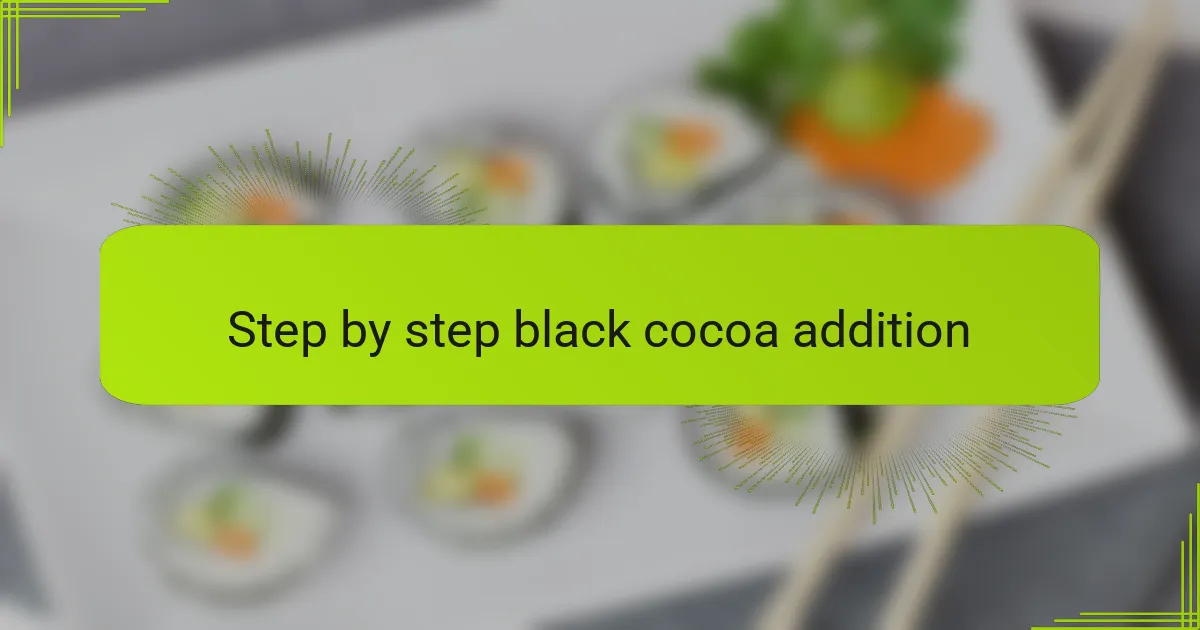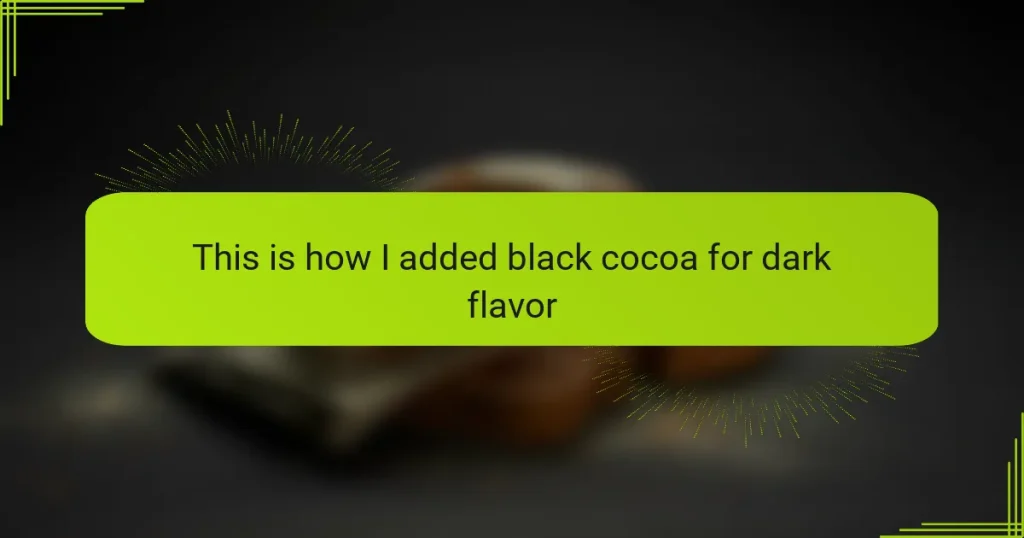Key takeaways
- Black cocoa enhances the flavor and appearance of desserts, offering a deep, bittersweet taste and striking visual appeal.
- Adjustments are necessary when substituting black cocoa, including tweaking liquids and sweetness to maintain balance and texture.
- Selecting high-quality, finely milled black cocoa can prevent undesirable texture issues in baked goods.
- Experimenting with complementary flavors like coffee or spices can elevate the overall chocolate experience in desserts.

Understanding black cocoa usage
When I first discovered black cocoa, I was surprised by its intense, almost smoky flavor compared to regular cocoa powder. It’s not just darker in color; it transforms desserts with a deep, rich chocolate taste that’s hard to replicate. Have you ever wondered why some chocolate treats taste so bold? That’s the magic of black cocoa coming through.
Using black cocoa isn’t always straightforward, though. Because it’s more concentrated and less acidic than natural cocoa, it can affect the texture and color of your baked goods in unexpected ways. I remember my first batch of cookies turned almost black, and I had to adjust the recipe to balance the flavor without overpowering the other ingredients.
What I learned is that black cocoa works best when paired thoughtfully with other flavors and fats. It’s perfect for creating that dramatic dark look and bitter-sweet profile in desserts. Have you tried substituting black cocoa in your recipes? It’s a small change that makes a big difference, and once you get the hang of it, your desserts feel like they’ve been taken to another level.

Benefits of black cocoa in desserts
One of the biggest benefits I noticed with black cocoa is how it instantly amps up the visual drama of desserts. There’s something about the deep, almost velvety black tone that makes cakes and cookies look so striking. Isn’t it amazing how just a change in color can make your dessert feel more indulgent before you even take a bite?
Flavor-wise, black cocoa brings this beautifully intense, bittersweet depth that regular cocoa just can’t match. I remember adding it to a chocolate tart and being blown away by the complexity it gave—less sweet, more profound. Have you ever craved that rich, dark chocolate experience that lingers on your tongue? That’s what black cocoa delivers every time.
Beyond taste and appearance, I also appreciate how black cocoa’s lower acidity helps balance recipes. It creates a smoother, more mellow chocolate note without making desserts overly tangy. This subtle shift can make the texture feel richer and more satisfying, which, at least for me, takes homemade desserts from good to truly memorable.

Choosing the right black cocoa type
Not all black cocoa powders are created equal, and choosing the right one can really make or break your dessert. I learned this the hard way when I grabbed a brand that was too bitter and grainy, which threw off the balance in my brownies. Have you ever noticed a harsh, almost burnt flavor in your chocolate treats? That’s often a sign you might need a smoother, more refined black cocoa.
When I shop for black cocoa, I look closely at the label to see if it’s dutched, meaning it’s treated with alkali to mellow its acidity. This process not only deepens the color but also softens the flavor, creating that luxurious, almost velvety taste I want in my desserts. It’s a small detail, but it dramatically changes how the cocoa behaves in a recipe.
Texture matters too. In my experience, some black cocoas are finer and blend effortlessly, while others are coarser and can affect the batter’s consistency. Have you ever had a lumpy batter that just wouldn’t smooth out? Choosing a finely milled black cocoa will save you from that frustration and ensure your dessert turns out beautifully dark and silky every time.

Adjusting recipes for black cocoa
When I first started swapping regular cocoa for black cocoa, I quickly realized the importance of adjusting the recipe. Because black cocoa is so intense and absorbs more liquid, I had to tweak the wet ingredients slightly to keep my batter from turning too dry or dense. Have you ever noticed your dough feeling stiffer than usual? That’s a clue to add a touch more moisture.
Balancing sweetness is another adjustment I found essential. Black cocoa’s deep, bitter flavor can dominate if you don’t compensate with a bit more sugar or a complementary ingredient like vanilla. I remember my initial attempts were almost too sharp, but a small increase in sweetness softened that edge beautifully. Don’t you love when a simple tweak transforms your dessert into something perfectly harmonious?
Texture also deserves attention. Because black cocoa is less acidic, it can affect leavening agents like baking soda differently. I learned to watch the rise and sometimes reduce baking soda slightly to avoid a collapsed crumb. Have you ever baked a cake that sank in the middle? Changing cocoa types can be sneaky, but with a little practice, you get the hang of making adjustments that keep your dessert light and tender.

Step by step black cocoa addition
The first time I added black cocoa to my recipe, I started by replacing the regular cocoa powder one-for-one. It seemed simple enough, but I quickly noticed the batter turned much darker and thicker than I expected. Have you ever wondered how such a small swap can change the whole texture? That moment taught me to go a bit slower and observe carefully.
Next, I sift the black cocoa before mixing to avoid clumps, which can be stubborn given its dense nature. Sometimes, I even mix it with the dry ingredients separately to make sure it blends seamlessly. This step might seem minor, but it really helps keep the batter smooth and prevents any gritty surprises in the final dessert.
Finally, I adjust liquids and sweeteners after adding black cocoa, tasting the batter if possible. Because its intense bitterness can be tricky, I often add a splash of vanilla or a bit more sugar to balance it out. Have you tried fine-tuning flavors on the fly? For me, this hands-on approach turns the baking process into a fun experiment rather than a strict routine.

Personal tips for dark flavor
One tip I’ve learned is to start with a smaller amount of black cocoa than the recipe calls for and then adjust from there. I remember being eager to get that dark, rich flavor and overdoing it, which made my brownies almost too bitter. Have you ever gone too far and had to find a way to rescue your dessert? Scaling back a bit at first saves that disappointment.
Another thing I find helpful is pairing black cocoa with ingredients that naturally complement its bitterness—like coffee or a pinch of cinnamon. These flavors seem to deepen the chocolate experience without overwhelming it. I often experiment with these additions and enjoy discovering how they gently lift the dark profile. Do you have favorite spices that you think bring out the best in chocolate?
Lastly, I always trust my senses when working with black cocoa. If the batter smells too sharp or tastes off before baking, I tweak the sweetness or moisture right away. It’s a bit like having a conversation with the ingredients. Have you ever done that—listened closely to your batter? It’s surprisingly rewarding and helps me create desserts that truly hit that perfect dark note every time.




